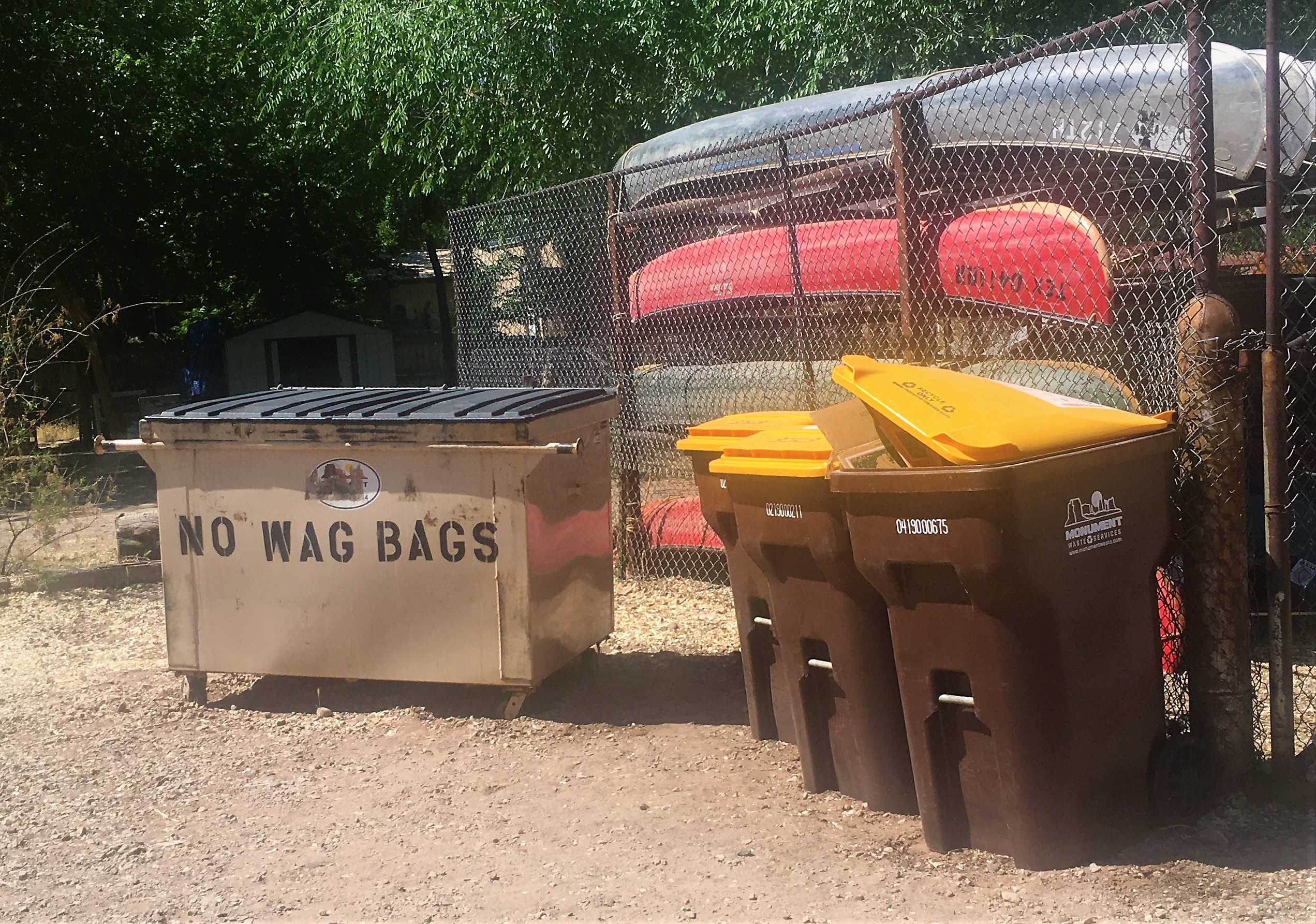Some information may be outdated.
Please, please don’t dispose of used wag bags in your regular trash can.
That’s the message that the Solid Waste Special Service District # 1, newly renamed the Canyonlands Solid Waste Authority after acquiring local control of Monument Waste, wants the public to know.
Wag bags, or human waste disposal systems, are bags used as portable toilets in remote areas to safely pack out solid human waste to avoid impacting the environment. While most of these bags are labeled as safe for landfills, the trash collection process in Moab involves compaction, which can rupture sealed bags and expose collection crews to human waste, creating both a mess and a biohazard.
“Several Monument staff members have been completely covered from head to toe from rupturing WAG bags when the hydraulic system on the truck engages, exposing them to several types of bodily fluids that have the potential to carry viruses and diseases,” District Manager Evan Tyrrell wrote in an email to the Grand County Commission on the subject.
“It happened to one of our guys last week,” Tyrrell added in a phone conversation with the Moab Sun News.
Instead of tossing used wag bags in with household trash, people must take them directly to the transfer station on South Highway 191.
Human waste management is one of the primary concerns of recreation and land management. According to a brochure from the Bureau of Land Management, highly visited areas with no public restrooms can develop high concentrations of human waste, posing environmental and health hazards. In areas like these, waste carry-out may be recommended or required by management agencies. Portable human waste disposal systems usually contain an inner disposal bag with a deodorizing, gelling powder and a sealable second bag in which to carry the used inner bag.
Once the used bags are carried out of the backcountry, where do they go? Most companies advertise that their wag bags are landfill-compatible and can be thrown away in the regular garbage.
“These bags are safe to dispose of in normal trash,” says the website for the company Cleanwaste of its waste disposal bags, adding that a starch derivative component of the powder in its inner bag helps the discarded product break down quickly under landfill conditions.
“Each leak-free bag seals easily and can be discarded in any trash receptacle,” says the FAQ page for Restop, another widely used wag bag company, comparing disposal of its product to throwing away baby diapers.
The difference between a diaper or a dog waste bag and a wag bag is that wag bags are, ideally, tightly sealed.
“The problem is that when they are sealed, they heat up, expand under pressure, and are susceptible to rupturing,” explained Tyrrell.
When garbage is thrown into trash compactor trucks, pressurized, used human waste disposal bags can explode.
To properly discard used wag bags, take them directly to the Moab Transfer Station at 2295 South Highway 191. For residents, disposal of up to five wag bags is free. For outfitters and guides, or for more than five bags, there is a fee of two dollars per bag.
Local guide companies have had to come up with solutions for their clients’ waste on multi-day commercial trips in the backcountry for years—their permits may depend on the practice of acceptable waste disposal protocols.
Carl Dec, owner of local guiding company Red River Adventures, said his guides use a set-up in which a toilet seat is fixed to a hard-shell container and placed in a secluded area at the end of each day on a trip. All clients use the set-up like a regular toilet, and it’s packed up along with the rest of camp when the group moves on.
At the end of the trip, the waste is emptied into an RV dump the company has at its location, and the container is cleaned and reused. Dec said that while his guides carry wag bags on all trips, even single-day outings, “just in case,” many clients are reluctant to use them.
“Everyone has a remarkable ability to hold it when they’re out on the trail,” Dec said.
On multi-day backpacking trips, however, neither “holding it” nor a heavy hardshell common container are practical.
Lance Plank is the southwest program director for the outdoor education organization Outward Bound, and he explained that some of the group’s trips include up to 15 people, including instructors, on excursions as long as 30 days. Some of the routes traveled during these trips are in areas where wag bags are either required or considered best practice.
Outward Bound students store their wag bags in pieces of PVC pipe while hiking, to keep them protected from tears and separated from other gear. During resupplies and transfers, logistics staff collect used wag bags and deliver them to the Moab transfer station.
“There’s a pretty consistent disconnect between what the waste management practices are and what the land management agencies require,” he said. “Land managers hand out or require wag bags; but it comes down to this factor of, ‘I have this wag bag, what do I do with it?’”
Tyrrell said representatives from the Solid Waste Special Service District, the Southeast Utah Health Department and land management agencies have been meeting to discuss education efforts and potential improvements to human waste disposal options in Grand County.
Jonathan Dutrow, environmental health scientist at the SEUHD, has been working on aligning land managers and gathering resources to focus on the problem—not just the disposal of wag bags, but also of human waste building up in dispersed camping areas. Dutrow’s organizing efforts have been delayed by the pandemic, but said he is “making some good headway.”
Appreciate the coverage? Help keep local news alive.
Chip in to support the Moab Sun News.





